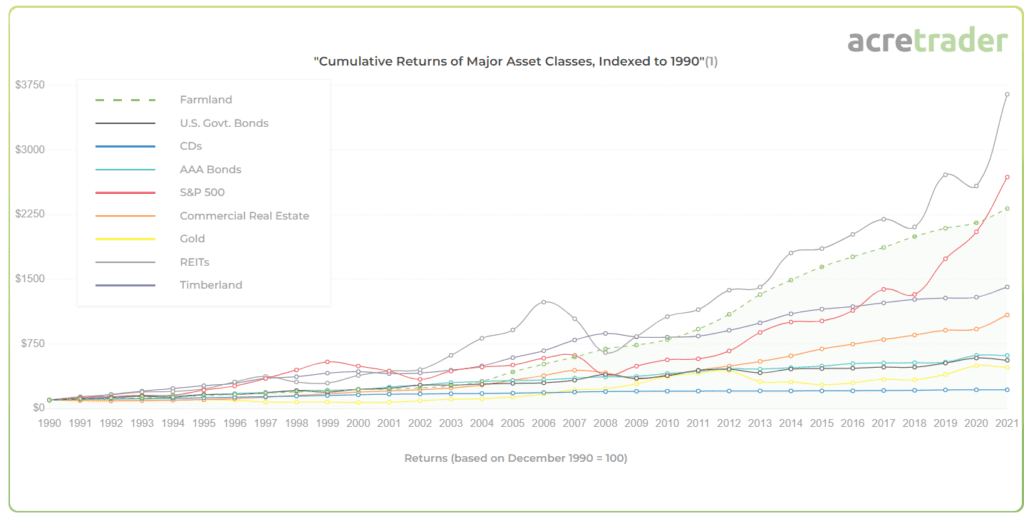This post may contain affiliate links. We may receive compensation when you click on links to those products at no additional cost to you. Read our full disclosure here.
Did you know that when it comes to investing, one of the richest men in the world, Bill Gates, has a soft spot for land? In fact, he is the largest landowner in the United States. And it’s not just because he has the money to buy up huge tracts of land – it’s because he recognizes that land is a scarce resource, particularly as the world’s population continues to grow. But is investing in land a smart move for the rest of us?
In this article, we’ll explore the pros and cons of investing in land, and help you determine whether this is a viable option for your investment portfolio.
What is Land Investing
Investing in land refers to purchasing a piece of land with the goal of making a profit on that investment. It can involve purchasing land that is already developed or purchasing undeveloped land with the intention of developing it in the future.
Now, I know what you’re thinking – “Isn’t investing in land just for rich people and big corporations?” Well, not necessarily! In fact, investing in land can be a viable option for anyone who has some money to spare and wants to diversify their investment portfolio through REITs and crowdfunding platforms like AcreTrader.
A big reason people buy land is because land is a finite resource, and as the population continues to grow, the demand for land will only increase. This means that the value of land could potentially increase over time, making it a valuable asset to hold onto.
Of course, like any investment, there are risks involved with investing in land. You could end up purchasing land in an area that doesn’t experience much growth or development, which could limit your potential return on investment. Plus, investing in land typically requires a significant amount of upfront capital, which may not be feasible for everyone.
Pros and Cons of Investing in Land

Pros of Investing in Land
- Tangible asset: One of the primary advantages of investing in land is that it is a tangible and scarce asset. Unlike stocks and bonds, which can fluctuate in value based on market conditions, land is a physical asset that you can see and touch that has a fixed supply.
- Potential for long-term appreciation: Land values tend to appreciate over time, especially if the area experiences population growth or development. Investing in land in a developing area can potentially yield significant profits in the future. See below for a chart showing how farmland performed. It showed decent returns with less volatility compared to REITs and the S&P500!

- Diversification: Land can be a good way to diversify your investment portfolio. It’s not subject to the same market forces that affect stocks and bonds, so it can provide a level of stability and protection against market volatility.
- Passive income: Investing in land can also generate passive income through rental income, leasing, or farming.
- Control: Investing in land can give you more control over your investment, as you have the ability to improve and develop the land to increase its value.
Cons of Investing in Land
- Illiquidity: and is an illiquid asset, meaning it can be difficult to sell quickly. It may take months or even years to find a buyer, which can limit your ability to access funds when you need them. Unlike stocks and bonds, which can be sold quickly and easily, it can be difficult to find a buyer for land, particularly if you are looking to sell quickly.
- High initial costs: One of the biggest disadvantages of investing in land is the high initial cost. Unlike stocks and bonds, which can be purchased for a relatively small amount of money, purchasing land often requires a significant investment unless you are purchasing via ETFs or funds, which of course negates the benefits of control.
- Ongoing costs: Owning land also comes with ongoing maintenance costs, such as property taxes, insurance, and upkeep. If the land is not generating income, these costs can quickly eat into your profits.
- Market fluctuations and economic instability: Land prices can also be subject to fluctuations based on market conditions and economic instability. For example, if there is a downturn in the housing market, land prices may also be affected. This can make it difficult to predict future returns on investment.
- Legal and regulatory hurdles: Investing in land can also be complicated by legal and regulatory hurdles. Depending on the location of the land, there may be zoning laws, environmental regulations, and other restrictions that can impact your ability to use or develop the land.
- Development risks: Investing in land with the intention of developing it can be risky, as there is no guarantee that the development will be successful or profitable.
Types of Land Investment
If you want to invest in land, you need to know that there are many types of land investments. Knowing what each type of land investment is and how it fits into your overall portfolio goals is crucial as well in terms of risk and return profiles. Some common types of land investments include:
- Raw land: This is undeveloped land that is not currently used for any specific purpose. Investors can buy raw land with the intention of developing it in the future or holding onto it as a long-term investment.
- Agricultural land: This type of land is used for farming and ranching. Investors can purchase agricultural land and lease it to farmers or ranchers for a passive income stream.
- Residential land: This refers to land that is zoned for residential use, such as building homes, apartments, or condominiums. Investors can buy residential land with the intention of developing it for residential purposes.
- Commercial land: This type of land is zoned for commercial use, such as building shopping centers, offices, or hotels. Investors can purchase commercial land with the intention of developing it for commercial purposes or leasing it to businesses.
- Industrial land: This type of land is zoned for industrial use, such as building factories, warehouses, or distribution centers. Investors can buy industrial land with the intention of developing it for industrial purposes or leasing it to businesses.
- Vineyards: This type of land is used for growing grapes, which can be used to produce wine. Investors can purchase vineyards with the intention of producing and selling their own wine or leasing the land to wine producers for a passive income stream.
- Orchards: This refers to land that is used for growing fruit trees, such as apple, cherry, or peach trees. Investors can buy orchards with the intention of selling the fruit produced on the land or leasing the land to fruit growers for a passive income stream.
How to Invest in Land
If you liked what you’ve heard so far and are interested in investing in land, there are several ways to do so, indirectly and directly:
- Buying land straight up: This is a simple and straightforward way to invest in land. Raw land is undeveloped land that has not been built on or improved in any way. Investors can buy land directly through land real estate agents and brokers. You may need significant upfront capital for this option.
- Invest in real estate investment trusts (REITs): REITs are companies that own and operate income-producing real estate. By investing in a land REIT like Gladstone Land, (NYSE:LAND), investors can indirectly invest in land without having to manage the land themselves.
- Invest in ETFs that are tied to land productions: ETFs are funds that track a certain index or sector. Investors can invest in ETFs that give investors exposure to the land market like timber, oil and gas, etc.
- Join a land investment group: Joining a land investment group can be a great way to invest in land without having to put up a lot of capital. In a land investment group, investors pool their resources together to purchase land.
- Buy land with a partner(s): Investors can team up with a partner to buy land together. This can help to spread the financial risk and make it more affordable to invest in land.
Tips for Investing in Land
Location is key
Location, location, location! This is a real estate cliché for a reason. The location of your land can have a huge impact on its value. Look for land in areas that are experiencing growth and development, as this can increase the value of the land over time.
You don’t want to end up with a piece of land in the middle of nowhere that nobody wants to buy.
Do Thorough Research
Before investing in land, it’s important to do your due diligence. This means researching the local real estate market, zoning laws, and any other regulations that may impact your investment. You should also research the history of the land, including any previous use or development, to ensure that there are no potential issues that could impact the value of the land.
Trust us, you don’t want to end up with a piece of land that’s contaminated or has some other issue that you didn’t know about.
Consider future developments
When investing in land, it’s important to consider future developments in the area. For example, if there are plans for a new highway or commercial development nearby, this could increase the value of the land in the future.
On the other hand, if there are plans for a new landfill or other undesirable development, this could decrease the value of the land. So do your research and make sure you have a good sense of what the future holds for the area where you’re considering investing.
Seek expert advice
Investing in land can be complicated, particularly if you’re new to the market. That’s why it’s a good idea to seek advice from a real estate agent or other expert in land investment.
They can help you navigate the process and make informed decisions about your investment.
Conclusion
Investing in land can be a smart way to diversify your investment portfolio and potentially earn a high return over the long term. However, there are also potential drawbacks to consider, including high initial costs, limited liquidity, and legal and regulatory hurdles. Before investing in land, it is important to do your research, consider future developments, and seek expert advice to ensure that you make an informed decision.
FAQs
Is investing in land a good investment?
Investing in land can be a good long-term investment strategy, especially in areas with growing populations and development. However, it is important to do your research and understand the potential risks and rewards before investing.
How much does it cost to invest in land?
The cost of investing in land can vary greatly depending on factors such as location, size, and zoning regulations. It is possible to invest in land with a relatively small amount of capital, but larger investments may be necessary for more desirable properties.
How long should I hold onto land before selling it?
The length of time you should hold onto land before selling it can vary depending on market conditions and your investment goals. Some investors may hold onto land for years or even decades to maximize their returns, while others may sell sooner to take advantage of market fluctuations.
What are some of the risks associated with investing in land?
Some of the risks associated with investing in land include market fluctuations, zoning changes, environmental issues, and the potential for natural disasters. It is important to do your research and understand these risks before investing in land.
This post may contain affiliate links. We may receive compensation when you click on links to those products at no additional cost to you. Read our full disclosure here.






